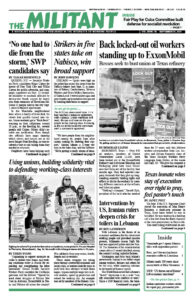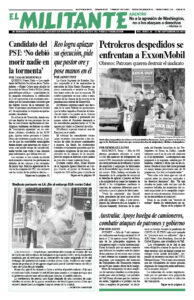The following excerpt is from the opening section of “The Stewardship of Nature Also Falls to the Working Class: In Defense of Land and Labor,” a Socialist Workers Party resolution published in New International no. 14. Copyright © 2008 by New International. Reprinted by permission.
Labor’s transformation of nature is the source of all wealth, all advances in social productivity, culture, and conservation. It is the very foundation for the ongoing existence of our species.
At the same time, from the earliest stages of class-divided society, the propertied classes have organized labor to advance their private gain. They have done so with no concern for the social consequences of their methods. The exploiters use labor as an expendable beast of burden, while they simultaneously deplete the soil, destroy forests through slash-and-burn or other farming methods, wipe out animal life through overhunting and overfishing, and poison streams, ponds, and other bodies of water.
Thus, over the thousands of years since the rise of private property, the relationship between social labor and the natural environment has been marked by the mutually contradictory poles of transformation and destruction. It has been, and remains, a relationship determined by social contradictions, not by natural laws.
Since the rise of industrial capitalism in the mid-1700s, the productivity of social labor has increased at a quickening pace, and with the consolidation of the imperialist world order at the opening of the twentieth century, the degree of labor’s alienation from nature and from its own fruits has become greater than ever before in history. The stakes for the earth’s toilers in eradicating that separation by putting an end to the dictatorship of capital increase daily.
Science and technology — which are developed and used by social labor — have established the knowledge and the means to lessen the burdens and dangers of work, to advance the quality of life, and to conserve and improve the earth’s patrimony.
It is possible today to end once and for all the material, social, and political conditions that have ravaged the lives of countless generations of slaves, serfs, bonded labor of all varieties, peasants, and rural and urban workers and their families.
It is possible to end the treatment of toilers past their prime laboring years as used-up tools, whose demands for food, clothing, shelter, and health care are a regrettable deduction from profits.
It is possible to end the unsustainable private obligations imposed on individual families for the welfare of the young, the elderly, the ill — all of which are social responsibilities that pay tribute to human solidarity.
It is possible to end deaths, maimings, and disease from overwork, hunger, and lack of sanitation.
It is possible to end the slaughter of untold hundreds of millions due to wars of conquest, enrichment, and domination by the ruling classes.
It is possible to end capital’s ever-extending exploitation of nature and labor, with its devastating toll on the constantly growing numbers of working people in the semicolonial world who are being drawn into the capitalist mode of production.
Yet under capitalism — the last of the world’s exploitative property systems — this liberating potential is turned into its opposite. So long as labor remains an inextricable component of the ruthlessly acquisitive, unplanned, and violent operations of the market system, increased productivity simultaneously reproduces the social relations of production specific to capitalism — social relations that perpetuate workers’ own exploitation and oppression. As a result of the unceasing competition among capitalists to maximize profits, the product of labor’s exertion ends up worsening the perils to workers’ life and limb; polluting the soil, waters, and skies; and endangering civilization’s very survival from the use of massive arsenals of nuclear weapons and delivery systems.

